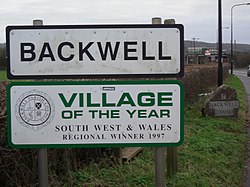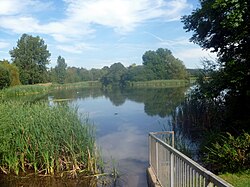Backwell
| Backwell | |
| Somerset | |
|---|---|

| |
| Location | |
| Grid reference: | ST485685 |
| Location: | 51°24’47"N, 2°44’23"W |
| Data | |
| Population: | 4,589 (2011[1]) |
| Post town: | Bristol |
| Postcode: | BS48 |
| Dialling code: | 01275 |
| Local Government | |
| Council: | North Somerset |
| Parliamentary constituency: |
North Somerset |
Backwell is a village and parish in the Hartcliffe Hundred of Somerset.[2] It had a population of 4,589 at the time of the 2011 census.[1] It is seven miles south-west of Bristol, on the A370 road to Weston-super-Mare. It includes the hamlets of Backwell Common, Backwell Green and Backwell Farleigh and the districts of Backwell West Town and Downside.
Nearby are Nailsea, Flax Bourton, Yatton, Brockley and Barrow Gurney.
History
Backwell Hillfort between Flax Bourton and Backwell is an Iron-Age hill fort.[3]
The village has a long history, appearing in the Domesday Book in 1086 with the name 'Bacoile' meaning 'The well back on the hill'.
The lords of the manor from the 12th to 17th centuries were the Rodneys. Walter de Rodney was given the manor for his support of the Empress Matilda against King Stephen.[4]
Backwell House is an historic house in the village which is now a popular hotel and wedding venue

Geography

Backwell lake, which is also known as Buckland's Pool, is next to the road between Nailsea and Backwell at Buckland's Batch. The lake was built as a balancing pond in the mid-1970s It has now become a wildlife haven for birds, bats and dragonflies, which are attracted by the open water and surrounding vegetation. Bird species include gadwall, shoveler, pochard, tufted duck, grey heron and mute swans.[5]
Stancombe Quarry was first built in 1952. Today, the quarry which is operated by Tarmac, produces Carboniferous Limestone, which is mainly for use on the roads,[6] after crushing on site.[7] The site has an expected output of 28 million tonnes over a 25-year period.[8] The now defunct Coles Quarry, in the north of the village, also produced limestone until it was closed by North Somerset Council.[9]
Playing Fields
Backwell Playing Fields is a 17-acre public park and a collection of sports fields in the western side of Backwell. Its slogan is "The jewel in the centre of our village" [10]
On 6 June 1929 Theodore Robinson opened the park to the public [11] and gave it to the "Children and adults of the parish of Backwell". The fields were opened on June 6, 1929 by the then Marquis of Bath, Thomas Thynne.[12]
As the fields were given to the collective people of Backwell, they had, and continue to have, no sole owner. The fields are, however, managed and maintained by a team of directors of the Backwell Playing Fields Charity.[10]
The fields are often used for playing football, mainly for Ashton and Backwell United FC's home games, as the club's home and stadium is at the Playing Fields. Other sports grounds at the Fields are Backwell Tennis Club, West Backwell Bowling Club, and Backwell Judo Club. The fields are also home to a youth club. 1st Backwell Scouts hut is just outside the park boundaries, but the fields are used a lot by them for their outdoor activities.
Education
The largest junior school in Backwell is Backwell Church of England Junior School, which provides education to 240 children aged between 7 and 11. In addition there is West Leigh Infant School which covers reception and Key Stage 1. In 2013, West Leigh and Backwell Junior schools became a federation.[13]
A private primary school, Fairfield PNEU, is located in the village, having been founded in 1935 and moved to its current site in 1947.[14]
The secondary school, Backwell School, attracts pupils from surrounding areas, including Bristol and Yatton. Alumni include Richard Ottaway, politician[15] and the author Joel McIver.[16]
Transport
Many residents of Backwell commute daily to Bristol by car via the A370, and public transport. The closest motorway is the M5.
Nailsea and Backwell railway station is at the north end of the village. It was opened in 1841 by the Bristol and Exeter Railway and subsequently run by the Great Western Railway.[17] The station has regular services between Taunton, Weston-super-Mare and Cardiff, as well as some peak services directly to and from London Paddington. The station is mostly unstaffed, except during the morning peak.[18] The direct service to London makes the village popular with commuters willing to spend four hours a day travelling by train.[19]
Bristol Airport is at Lulsgate Bottom, which borders the district of Downside, three miles from the centre of Backwell. The airport serves both domestic and international routes.
Religious sites

The Anglican parish church of St. Andrew dates from the 12th century. It was altered and enlarged in the 13th, 15th, 16th and 17th centuries. It has been designated as a Grade-I listed building.[20]
The tower at the west end of the church is over 100 ft tall and dates from the 15th century. It contains a ring of eight bells, two of which are mediæval.[21]
The font dates from the 12th century. It consists of a circular bowl with cable moulding, and a circular stem with foliate moulding on the base. It was restored in 1907.[20]

West Town Methodist is a Wesleyan Zion chapel on the A370 road in Backwell West Town. It was renovated from a house in 1853 when ten Methodist Backwell residents clubbed together to purchase it and renovate it into the chapel. The church underwent an interior renovation in 1992 which saw a doubling in membership.[22]
There is also a modern Baptist church on Chapel Hill.
Sport
Ashton & Backwell United F.C. was originally called Backwell United but then merged with one of Bristol's largest youth club's Ashton Boys FC. They are currently members of the Western League First Division. They moved to their current home in 1947, the Backwell Recreation Ground.
Backwell Karate, also known as Backwell Shotokan Karate Club, was established in the village in 1978 and is a member club of the Karate Union of Great Britain governing body.
Backwell Golf Club (now defunct) first appeared during the 1890s. The club closed prior to WW1.[23]
References
- ↑ 1.0 1.1 "2011 Census Profile" (Excel). North Somerset Council. Archived from the original on 4 January 2014. https://web.archive.org/web/20140104204530/http://www.n-somerset.gov.uk/Environment/Planning_policy_and-research/researchandmonitoring/Documents/North%20Somerset%20Small%20area%20geography%20profiles%20tool.xls. Retrieved 4 January 2014.
- ↑ "Somerset Hundreds". GENUKI. http://www.genuki.org.uk/big/eng/SOM/Miscellaneous/. Retrieved 9 October 2011.
- ↑ "Backwell Hillfort". Hillfort in England in Somerset. Megalithic Portal. http://www.megalithic.co.uk/article.php?sid=25046. Retrieved 15 January 2011.
- ↑ Dunning, Robert (1980). Somerset & Avon. Bartholomew. pp. 30. ISBN 0-7028-8380-8.
- ↑ "Bucklands Pool/Backwell Lake". Natural England. Archived from the original on 24 July 2011. https://web.archive.org/web/20110724020639/http://www.lnr.naturalengland.org.uk/special/lnr/lnr_details.asp?themeid=1008788. Retrieved 28 August 2010.
- ↑ Stancombe Quarry production
- ↑ "Hazemag at Stancombe Quarry". Aggregates and Recycling Information Network. Archived from the original on 7 July 2011. https://web.archive.org/web/20110707093542/http://www.agg-net.com/case-study/hazemag-at-stancombe-quarry. Retrieved 29 January 2011.
- ↑ "Contaminated land inspection strategy November 2001 (revised 2003)". North Somerset Council. Archived from the original on 8 March 2012. https://web.archive.org/web/20120308110947/http://www.n-somerset.gov.uk/nr/rdonlyres/68c27eab-cfb0-4a49-9506-77971320552e/0/strategy_contaminatedlandstrategy.pdf. Retrieved 29 January 2011.
- ↑ "Report - - Coles Quarry, Backwell - April 2015". 28DaysLater.co.uk. http://www.28dayslater.co.uk/coles-quarry-backwell-april-2015.t96405. Retrieved 2017-01-01.
- ↑ 10.0 10.1 "Home - Backwell Playing Fields". Archived from the original on 22 December 2015. https://web.archive.org/web/20151222121855/http://www.backwellpark.co.uk/. Retrieved 2015-12-14.
- ↑ "Backwell Park". Backwell Playing Fields Association. Archived from the original on 4 September 2011. https://web.archive.org/web/20110904212027/http://www.backwellpark.co.uk/history. Retrieved 28 August 2010.
- ↑ Information given on the plaque on the stone in the Playing Fields (pictured in the article): "It was opened on 6th June 1929 by The Most Honorable The Marquis of Bath K.G."
- ↑ "Welcome to Our Federation". http://www.backwellfederation.co.uk/welcome/. Retrieved 27 October 2016.
- ↑ "History". Fairfield School. Archived from the original on 8 September 2010. https://web.archive.org/web/20100908000602/http://www.fairfieldschool.org.uk/History.php. Retrieved 28 August 2010.
- ↑ "Richard Ottaway". BBC News Online. 2001. http://news.bbc.co.uk/hi/english/static/vote2001/candidates/candidates/1/17106.stm. Retrieved 13 February 2008.
- ↑ Interview in Venue magazine, 2008
- ↑ MacDermot, E.T. (1931). History of the Great Western Railway, vol. II: 1863–1921. London: Great Western Railway. pp. 133–4, 617. OCLC 55853736.
- ↑ "Nailsea & Backwell (NLS)". National Rail. http://www.nationalrail.co.uk/stations/nls.html. Retrieved 1 April 2012.
- ↑ Emmett, Susan (28 March 2008). "The West of England: the new commuter belt". The Times. http://property.timesonline.co.uk/tol/life_and_style/property/article3632029.ece. Retrieved 3 October 2009.
- ↑ 20.0 20.1 "St. Andrew's Church". Images of England. English Heritage. http://www.imagesofengland.org.uk/Details/Default.aspx?id=33417. Retrieved 7 March 2009.
- ↑ "History". St Andrew's Church, Backwell. Archived from the original on 27 April 2011. https://web.archive.org/web/20110427020140/http://www.standrewsbackwell.org/History.htm. Retrieved 5 April 2009.
- ↑ "A Brief History" (in en-US). backwellmethodists. 2013-11-26. https://backwellmethodists.wordpress.com/a-brief-history/. Retrieved 2017-01-04.
- ↑ “Backwell Golf Club”, “Golf’s Missing Links”.
Outside links
| ("Wikimedia Commons" has material about Backwell) |
- Backwell at the Open Directory Project
- Backwell Church of England Junior School
- Backwell Parish Council
- Backwell in the Domesday Book
